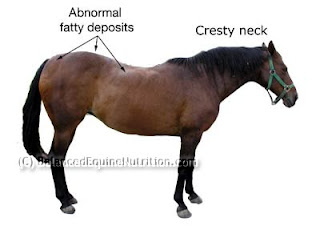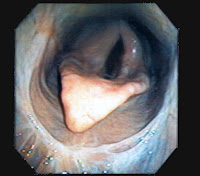Aahhh, spring! Goodbye to cold and hello to flowers
blooming, trees coming back to life and green, thick, lush grass in our
pastures. It's so satisfying to watch our horses merrily munching
away. But lurking in those waving fields
of green are some serious threats to your horse’s health.
Sugars, Starches and Fructans ,
OH
Laminitis
 When horses graze, their digestive enzymes break down the
grass into glucose, which is readily absorbed by the body. But, if blood glucose levels become too high,
the laminae in the hooves can soften and detach. This allows the Coffin bone to sink and
results in laminitis, a painful condition that, if not caught early, can cause
permanent damage.
When horses graze, their digestive enzymes break down the
grass into glucose, which is readily absorbed by the body. But, if blood glucose levels become too high,
the laminae in the hooves can soften and detach. This allows the Coffin bone to sink and
results in laminitis, a painful condition that, if not caught early, can cause
permanent damage.Insulin Resistance
When cells become less sensitive to the action of insulin,
which controls sugar levels in the body, cells can store too much glucose. A diet high in non-structural carbohydrates,
as is found in new spring grass, can contribute to this condition. Abnormal fat deposits (e.g. above the eyes),
excessive drinking and urinating, and laminitis are all symptoms of insulin
resistance.
Nasopharyngeal Cicatrix Syndrome (NCS)
Often referred to as simply “Cicatrix”, this condition
involves the pharynx, which becomes inflamed and irritated. Over time, the inflammation can lead to
scarring that narrows and constricts the airway to a degree that sometimes
requires a permanent tracheostomy to allow the horse to breathe. While fresh spring grass isn’t the direct
cause, the fungus, mold and pollen hiding within it can cause the irritation
that leads to the condition.
Grass Glands
Have you ever brought you horse in from the field and found
large, firm and usually painless swellings in the area where the throatlatch
would rest? It’s enough to freak out the
unprepared owner! These lumps, which may
even be accompanied by fluid under the skin, are often mistaken for a symptom
of the Strangles virus.
But, fear not! They are simply swellings of the parotid
salivary glands and they will retreat on their own, causing no discomfort to
your horse.
There are
ways you can help your horse avoid these complications of grazing in new spring
forage.
- Graze at night. Photosynthesis triggers the sugar in
grass, so the peak accumulation of sugar is between 3-8pm. The lowest amount of sugar is between
9pm and 8am, so grazing during these hours will be safest.
- Limit grazing time. If you don't want to keep these kinds of
hours (yawn!), then limit grazing to 1 hour a day for 3-4 days, then increasing
in 30 minute increments with each cycle. Max time out for a horse with
issues would be 4-6 hours.
- Reduce his intake. Muzzles can cut forage intake in half,
while still allowing your horse to hang out with his friends and enjoy the
new grass.
- Exercise. Daily exercise will work off the sugars
your horse has ingested, off-setting the potential harmful effects.
But, if
your horse has no health issues and green grass doesn't seem to bother him,
then grazing 24 hours a day has actually been shown to REDUCE insulin peaks due
to decreased consumption of grass.
Horses allowed to graze constantly will actually stop when they feel
full, while those kept in a dry lot and let out to graze tend to gorge
uncontrollably.
Of course,
here in Texas


